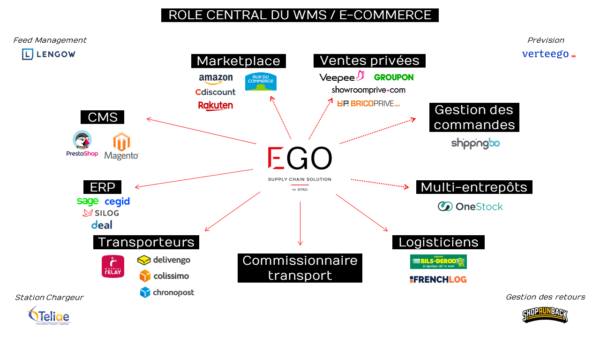WMSs are at the heart of a company’s physical, financial and information flows. As a result, it recovers or captures, aggregates and returns large quantities of data. It obviously includes the classic management of warehouse processes, from reception to dispatch.
But a WMS is not intended to have infinite functional coverage. Therefore, some publishers offer “bridges” (also called “connectors”) with partner IT solutions (ERP, MES, WCS, APS, TMS, etc.) that allow you to extend what the WMS traditionally does.
What software can be interfaced with a WMS?
Why are WMS publishers so keen on them?
How are these new solutions proposed?
What are the benefits for the company?
Rather than making heavy and time-consuming R&D investments, most publishers have, over the last few years, taken steps to identify niche players (or “best of breed”), often start-ups, in order to create alliances. These new services are often offered via the activation of optional modules (add-ons), sometimes on a “white label” basis and with these services billed on a per-use basis.
The aim of these publishers is to be able to offer new services to the market quickly, with the WMS remaining the “centre of the village”, the element of coherence, the functional/business layer federating all these solutions.
WMS are therefore evolving and are increasingly becoming “logistics ERPs”, combining modular functions around a logistics “core” that can be interfaced with third-party solutions. The objective is clear: not to be “subjected” to interfacing needs but to anticipate them, or even to anticipate the future needs of customers.
As a result of its positioning as execution software in the warehouse, the WMS plays a crucial role in the feedback of data to the entire IT ecosystem of a company, and in answering essential questions as diverse as:
Have I received my raw materials or finished products?
Where are my products in the warehouse?
In what quantities? Are they available?
Are they being prepared? When are they being shipped?
This information will allow you to “talk” with many solutions:
Depending on the type of logistics business in which the WMS is “immersed”, its positioning may be different and its relationship with other IT solutions may change.
In this sector, the WMS plays a central role:

Here are some examples of issues that can be addressed between a WMS and expert solutions:
=> RETURNS MANAGEMENT
How to help a customer and his carrier who have to manage customer returns? How to avoid too much loss of goods by having information to limit the cost of return transport, and to get the best value from the resale?
Startups have specialised in the management of “bulky” and “oversized” returns (these returns quickly lose value when handled, even a dead loss). These startups can give a second life to these returns: photos of the return with its defects, putting it online on auctioneers’ websites to increase the value of the returns, selling the return (the good goes from 10% to 60% of its initial value in resale value!)
The aim is to compete with sale outlets by paying the person holding the return stock more.
=> TRACKING – TRANSPORT CLAIM
What to do when a carrier does not honour its deadlines? How to proceed with a complaint in due form while having elements of proof?
A WMS has all the necessary information to warn the customer of the risks of delay: “you had planned to receive the goods on Saturday morning, but you don’t need to prepare to receive them because we know that it will be at least Monday”. This information can be supplemented by information from a TMS.
The objective here is to give access to this information, formatted in a dashboard or communicated via a workflow function, to the sales representatives (sales administration) in order to better inform their customers about possible delays or to be “better armed” when it comes to applying contractual penalties to their carriers.
=> MDM – MOBILE DEVICE MANAGEMENT
How can you ensure that the equipment used in several warehouses is working properly in real time?
Thanks to MDM solutions, logisticians have remote access to the mobile terminals present in a warehouse in order to see what the warehouse workers “see” on their PDAs, independently of geolocation, in order to troubleshoot them remotely.
=> DIMENSIONING AND WEIGHTING OF INCOMING ITEMS
How to proceed when the attributes of a product (weight, size, etc.) are not known at the time of reception?
At the entrance of the warehouse, it is possible to interface with dedicated equipment allowing the acquisition of these data in the WMS via, for example, measurement tables (via Cubiscan®, Cargoscan from Mettler Toledo, infrared or laser technologies, cameras and photo taking…)
=> DYNAMIC PARAMETERIZATION OF A PICKING AREA
How to ensure that the parameters for good stock management are relevant, especially when activities fluctuate during the year?
There are tools that allow dynamic management of storage parameters (replenishment threshold, etc.) depending on the product’s lifespan. For a product with erratic sales or new products, the behaviour and supply strategies must be distinct. Artificial intelligence tools can therefore analyse large quantities of data in order to propose new parameters for managing picking stocks: for example, by analysing historical data and the non-regular nature of a trend, abnormal behaviour can be capped…
